Everywhere you look these days, people are either writing about, or showcasing in a video, the power of Deathrite Shaman. Modern and Legacy have been the biggest benefactors of the printing of Deathrite Shaman, mainly because the fetch lands are legal in both formats. Legacy has the added bonus of Wasteland being legal. Standard has even seen a fair number of Deathrite Shamans despite the only legal “fetch land” being Evolving Wilds.
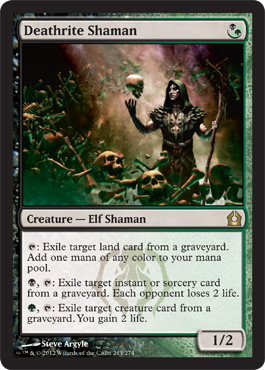
At the end of my last article I mentioned the fact that I completely dropped the ball on Deathrite Shaman. There are no excuses for my oversight, but I did offer up a brief review of the card to provide some insight into just how good it can be in Classic. Today, I’d like to take a more thorough look into how Deathrite Shaman fits into Classic before unveiling the deck that I recently built.
Building a Better Birds of Paradise
First, let’s review the merits of Deathrite Shaman. Much like Legacy, Classic has the requisite lands (Wasteland, Strip mine and fetch lands[/card]) to make Deathrite Shaman‘s first ability reliably useful. Between the fetch lands that are in your deck and those that are in your opponent’s deck, Classic offers plenty of ammunition to ramp out your mana and also fix any sort of color screw you might encounter. Much like Brainstorm, Deathrite Shaman and a fetch land make most opening grips much easier to keep, even if it’s only a 1- or 2-land hand. Mental Misstep is a serious concern, but that’s why you should run a full playset of Missteps in your Deathrite Shaman deck too.
As far has how you should create your own manabase, I advocate at least 7 Fetch Lands, if not 8 or even 9, in order to get the most use out of Deathrite Shaman. A smart opponent will know that their fetch lands will only be used as fodder for your Deathrite Shaman, and as such, they will use them conservatively, especially if you miss a land drop early on. This is why it’s necessary to include as many fetch lands of your own as you can reasonably fit in your deck.
Building a Better Grim Lavamancer
Deathrite Shaman‘s 2nd ability, exiling an instant or sorcery spell to deal 2 life loss to each opponent, is quite similar to Grim Lavamancer. Deathrite Shaman is not quite as flexible since it can’t target creatures or planeswalkers, but it is just as efficient in dropping life totals. Where Deathrite Shaman really shines is that your ammunition is both graveyards and it only requires 1 card to activate, instead of the 2 that Lavamancer needs. Deathrite Shaman is also slightly more adept in the red zone, as it has 2 toughness. There are probably only a few instances where the 2 toughness is relevant, but that’s more than the Lavamancer can speak for.
While less obvious, the hybrid color requirements of Deathrite Shaman make it more resilient to color screw. A single Wasteland on your Volcanic Island can render Lavamancer nothing more than a 1/1, but a Wasteland on your Underground Sea isn’t as much of a crushing blow if your other land in play happens to be a Tropical Island.
Building a Better Ghost-Lit Redeemer
You’re probably wondering what Ghost-Lit Redeemer is. Well, it’s the closest approximation to Deathrite Shaman that I could find, being that it is a 1-mana creature that can gain 2 life with a similar activation cost at a single mana. Naturally, it wouldn’t take much to make the Redeemer better, but tacking on the other 2 abilities of Deathrite Shaman certainly does the trick.
Cards that Get Better with Deathrite Shaman
I’ve spent a fair amount of time discussing why Deathrite Shaman is so good. I’d like to take a few minutes to discuss some of the other cards that Deathrite Shaman makes better as a result of its abilities.
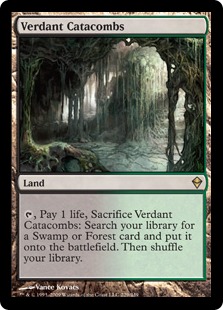
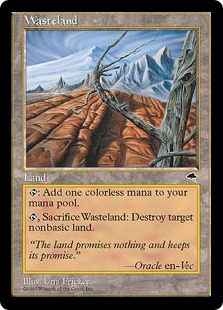
These cards have all been discussed above, but what hasn’t been discussed is a card that can make all three better and works well with the colors of Deathrite Shaman:
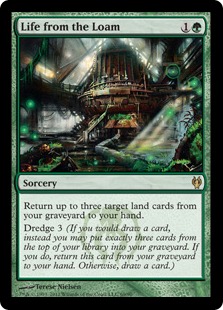
Loam isn’t quite as powerful in a format like Classic which is so fast, but it’s a card that can take over a grindy, control mirror match and even some aggro-control matchups as well, such as Delver. While it may seem like anti-synergy with Deathrite Shaman, the real key is putting more lands into your opponent’s graveyard with your Wastelands and Strip Mine. Replaying fetch lands can also help thin out your deck making each draw “live”. Further, Loam’s Dredge mechanic combines well with things like Snapcaster Mage, where your graveyard can be used as a resource.
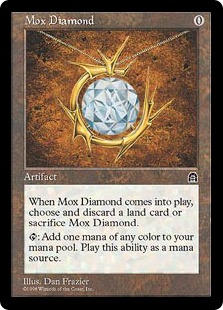
It’s been a real long time since Mox Diamond has seen Classic play. Discarding a land to keep it in play has been a significant drawback when most decks that want to accelerate with it likely only have 15-18 lands in it and can ill afford to lose one, especially when there are so many artifact hate cards running around.
That said, Deathrite Shaman changes the dynamic of placing lands into your graveyard early on. In fact, that land that gets pitched can actually act as a pseudo-Lotus Petal when paired with a Deathrite Shaman. Accelerating into a 3 drop is tricky in Classic, since there aren’t that many viable targets, but consider this opening sequence: Turn 1 – Land, Deathrite Shaman, go… Turn 2 – Land, Mox, Jace the Mind Sculptor. You could also throw out the Mox on Turn 1 to hold up mana for a multitude of instant speed 1-mana cost spells. That’s 6 cards to get to a Turn 2-Jace, but it certainly qualifies as a busted opening. Against Workshop’s Spheres, Mox Diamond and Deathrite Shaman are the closest things to the real Moxen that Classic can get at the moment.
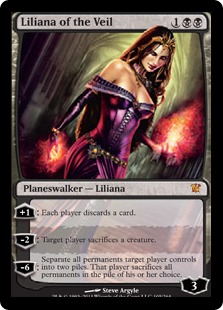
To date, one of my favorite planeswalkers has not made much impact in Classic. Liliana of the Veil has really only had a home in Dark Depths decks where her +1 ability is at its best to out-attrition your opponent. Elsewhere, Liliana has ranged from really great (a reusable Diabolic Edict) or downright pitiful (being overrun by a swarm of robots, mutant insects, or hate bears). Liliana does have some synergy however with Deathrite Shaman as she can help fill up each graveyard with ammunition each turn. Liliana’s ultimate is much less impressive but can be effective in some situations. Often the game is won long before you need to Fact or Fiction their permanents.
Putting it All Together…
Having said all that, I have spent the last couple of weeks building a BUG Control deck for Classic. It was a challenge that I laid out for myself at the end of my last article. It’s not a finished product by any means, but I do think it’s ready to be revealed for further analysis and tweaking amongst the player base. In fact, over the last week or so, I’ve started to play some mirror matches in the Tournament Practice room, so others may have already caught on. Without further ado, I present Deathrite Control:
Deathrite Control by enderfall
|
| ||||||||
How the Deck Works
On the surface, there isn’t much complicated about the deck. There also isn’t much “broken” in relation to other Classic decks. There is no Tinker or Time Vault-Voltaic Key. There isn’t even a large creature to cheat into play. The deck is designed to out-attrition the opponent, much like a Landstill deck would, but also to give it an aggressive slant to drop some early threats and ride them to victory.
Where this deck really shines is against aggro-control decks. Abrupt Decay is the key card for this matchup, and Snapcaster gives the deck some added reach by being able to cast them twice. There is also a singleton Dismember for threats that Decay cannot hit (Lodestone Golem is a prime example).
Against the Workshop decks, this deck can have some problems, but there are tools available, especially post-board, to help tilt the matchup in your favor. Lodestone is a real problem, however, and it’s important to counter that spell whenever possible. The other problematic card from Workshop is Chalice of the Void. Set at either 1 or 2 counters, Chalice can stop this deck cold. If you only counter two spells from Workshop, let these two be the ones you stop (Decay also works well here). Workshop decks make Deathrite Shaman slightly harder to use since they don’t have any instants or sorceries to place in their graveyard for you. Overall, this is probably the worst matchup for this deck and requires a lot of attention in the sideboard.
Dredge is barely winnable Game 1, per usual, but Deathrite Shaman can provide just enough disruption to possibly steal a game once in a blue moon. Post board, there are several tools available, including the maindeck Deathrite Shamans to make Games 2 and 3 much easier.
Combo decks are so few and far between these days that I have yet to face one in the TP room. On paper, there seems to be a chance that this deck can perform well if it can just get past Turns 1-3 and the Storm deck’s most busted hands.
As alluded to above, the control mirror is all about attrition. Control decks provide endless ammunition for Deathrite Shaman with their plentiful countermagic, Brainstorms, and fetch Lands.
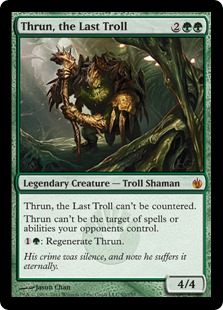
Perhaps the most peculiar card in the entire deck is the singleton Thrun, the Last Troll. I was looking for something that could not get hit by Abrupt Decay and was in BUG colors. I wanted to avoid a costly 6-drop, which might not last on the board even if I could hardcast it (the deck has no Mana Drain or artifact acceleration beyond the pair of Mox Diamonds). Thragtusk was a consideration, but he can be felled by both Lightning Bolt and Swords to Plowshares, the two most common removal spells in the format.
I stumbled upon Thrun, which I had bought for my Bant 100-Card Singleton deck a couple months earlier, and had an epiphany. Thrun can be forced through a wall of countermagic and can’t be Decayed, Plowed, or Bolted whatsoever. There are no mass sweepers going around, and aside from an occasional Perish, there is really nothing that is going to get Thrun off the board once he’s there. Yes, Tarmogyf can often block a Thrun all day long. However, that’s why Decay is important as a tool for the deck: to clear the way for Thrun to do his thing. There may come a day when Perish is more common and Thrun is less effective, but for the time being, Thrun is exactly what I’m looking for.
General Tips When Using Deathrite Shaman
Here are some things to keep in mind when using Deathrite Shaman. The correct line of play is to always target your opponent’s graveyard first for all 3 of Deathrite Shaman‘s abilities. It’s also very important to remember priority and understand possible situations where you could get blown out by your opponent gaining an advantage on the stack. Such a situation could be if you are looking to exile an instant from your opponents graveyard, such as a Brainstorm or a Swords to Plowshares. If they have 3 mana available, you could find yourself on the losing end of a Snapcaster Mage flashback.
Similarly, when staring down an opposing Deathrite Shaman, do not activate your Deathrite Shaman first, unless your opponent cannot pay for their Deathrite Shaman‘s activation! In most cases, a Deathrite Shaman mirror can turn into a staring contest. It’s wise to use your mana conservatively, and only when necessary to either improve board position or to stop a key threat from your opponent.
Also, it’s best to wait until the end of your opponent’s end step to use your Deathrite Shaman‘s 2nd and 3rd abilities. This gives you the flexibility to keep your mana open to potentially win a countermagic war, or to cast a removal spell on an important target. Further, it lets you choose the best option to exile in case your opponent plays something better during their turn. Waiting also gives you the option to choose between gaining life or dealing 2 damage to your opponent if you are low on life. If your opponent puts pressure on you on their turn, then you can keep your option to gain life open. 2 life can be the difference in tight games.
Format Defining Card
I’ve heard people say that Deathrite Shaman is the best 1-drop of all time. The more I get to play with it, the more I’m inclined to agree. I still can’t believe I missed him in my set review, but I’m more than making up for it by playing with him so much of late.
What do you guys think of the deck? Let me know what changes you think can be made to make the deck better, especially against Workshop decks.
enderfall
Clan Magic Eternal
Follow me on Twitter @enderfall


LOL, and of course, the day I discuss the merits of Thrun in Classic, WotC unveils this card:
http://media.wizards.com/images/magic/tcg/products/gtc/h0ndjlxf87_en.jpg
Solution = Find something with shroud
Well, even if Thrun is a major hit, I doubt Glaring Spotlight is going to see play in Classic. It’s tutorable with a Trinket Mage, but that’s about all it’s got going for it. I was just commenting on the crazy coincidence!
Love the idea of Thrun in this build. I also forgot about the synergy of Mox diamond and deathrite. Great article.